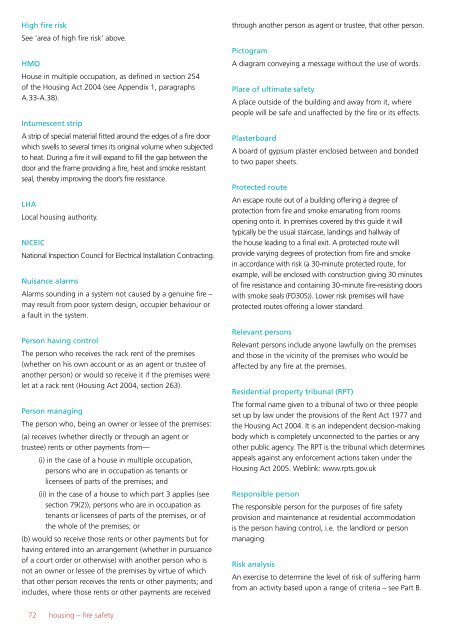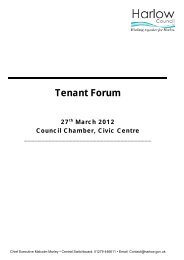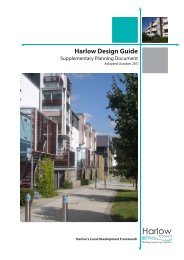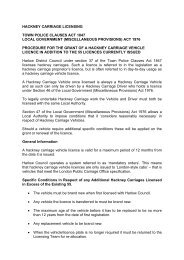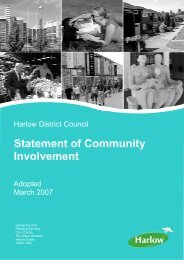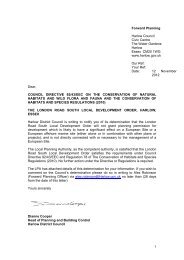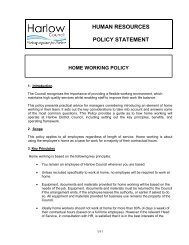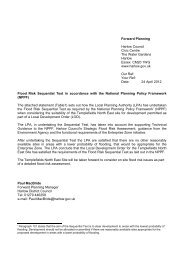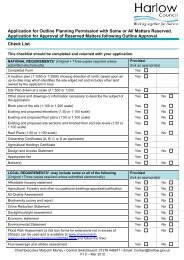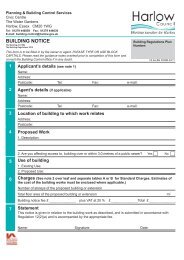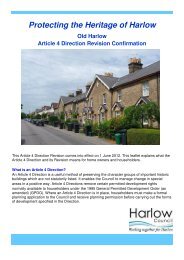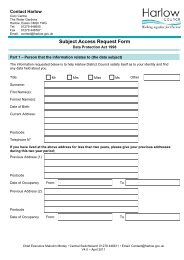HMO fire safety guidance - Harlow Council
HMO fire safety guidance - Harlow Council
HMO fire safety guidance - Harlow Council
You also want an ePaper? Increase the reach of your titles
YUMPU automatically turns print PDFs into web optimized ePapers that Google loves.
High <strong>fire</strong> risk<br />
See ‘area of high <strong>fire</strong> risk’ above.<br />
<strong>HMO</strong><br />
House in multiple occupation, as defined in section 254<br />
of the Housing Act 2004 (see Appendix 1, paragraphs<br />
A.33-A.38).<br />
Intumescent strip<br />
A strip of special material fitted around the edges of a <strong>fire</strong> door<br />
which swells to several times its original volume when subjected<br />
to heat. During a <strong>fire</strong> it will expand to fill the gap between the<br />
door and the frame providing a <strong>fire</strong>, heat and smoke resistant<br />
seal, thereby improving the door’s <strong>fire</strong> resistance.<br />
LHA<br />
Local housing authority.<br />
NICEIC<br />
National Inspection <strong>Council</strong> for Electrical Installation Contracting.<br />
Nuisance alarms<br />
Alarms sounding in a system not caused by a genuine <strong>fire</strong> –<br />
may result from poor system design, occupier behaviour or<br />
a fault in the system.<br />
Person having control<br />
The person who receives the rack rent of the premises<br />
(whether on his own account or as an agent or trustee of<br />
another person) or would so receive it if the premises were<br />
let at a rack rent (Housing Act 2004, section 263).<br />
Person managing<br />
The person who, being an owner or lessee of the premises:<br />
(a) receives (whether directly or through an agent or<br />
trustee) rents or other payments from—<br />
(i) in the case of a house in multiple occupation,<br />
persons who are in occupation as tenants or<br />
licensees of parts of the premises; and<br />
(ii) in the case of a house to which part 3 applies (see<br />
section 79(2)), persons who are in occupation as<br />
tenants or licensees of parts of the premises, or of<br />
the whole of the premises; or<br />
(b) would so receive those rents or other payments but for<br />
having entered into an arrangement (whether in pursuance<br />
of a court order or otherwise) with another person who is<br />
not an owner or lessee of the premises by virtue of which<br />
that other person receives the rents or other payments; and<br />
includes, where those rents or other payments are received<br />
through another person as agent or trustee, that other person.<br />
Pictogram<br />
A diagram conveying a message without the use of words.<br />
Place of ultimate <strong>safety</strong><br />
A place outside of the building and away from it, where<br />
people will be safe and unaffected by the <strong>fire</strong> or its effects.<br />
Plasterboard<br />
A board of gypsum plaster enclosed between and bonded<br />
to two paper sheets.<br />
Protected route<br />
An escape route out of a building offering a degree of<br />
protection from <strong>fire</strong> and smoke emanating from rooms<br />
opening onto it. In premises covered by this guide it will<br />
typically be the usual staircase, landings and hallway of<br />
the house leading to a final exit. A protected route will<br />
provide varying degrees of protection from <strong>fire</strong> and smoke<br />
in accordance with risk (a 30-minute protected route, for<br />
example, will be enclosed with construction giving 30 minutes<br />
of <strong>fire</strong> resistance and containing 30-minute <strong>fire</strong>-resisting doors<br />
with smoke seals (FD30S)). Lower risk premises will have<br />
protected routes offering a lower standard.<br />
Relevant persons<br />
Relevant persons include anyone lawfully on the premises<br />
and those in the vicinity of the premises who would be<br />
affected by any <strong>fire</strong> at the premises.<br />
Residential property tribunal (RPT)<br />
The formal name given to a tribunal of two or three people<br />
set up by law under the provisions of the Rent Act 1977 and<br />
the Housing Act 2004. It is an independent decision-making<br />
body which is completely unconnected to the parties or any<br />
other public agency. The RPT is the tribunal which determines<br />
appeals against any enforcement actions taken under the<br />
Housing Act 2005. Weblink: www.rpts.gov.uk<br />
Responsible person<br />
The responsible person for the purposes of <strong>fire</strong> <strong>safety</strong><br />
provision and maintenance at residential accommodation<br />
is the person having control, i.e. the landlord or person<br />
managing.<br />
Risk analysis<br />
An exercise to determine the level of risk of suffering harm<br />
from an activity based upon a range of criteria – see Part B.<br />
72<br />
housing – <strong>fire</strong> <strong>safety</strong>


